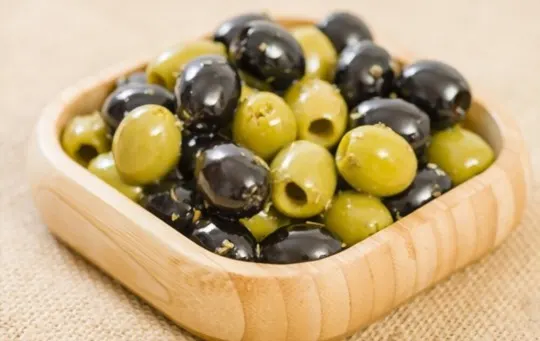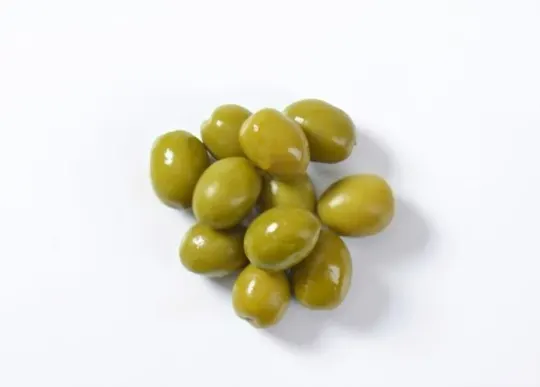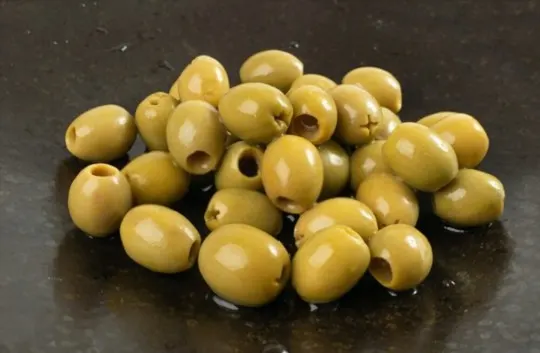Ever stared at a jar of olives and wondered what the fuss about pits is?
Olives, those small fruits we all debate over, come in two main varieties: pitted and unpitted.
Sure, they both start as olives. The difference? One keeps its wooden heart; the other loses it.
We’ve all been there, chomping down only to be met by an unexpected pit. Not fun.
Pitted olives are party-friendly, saving your teeth from unexpected surprises.
Unpitted olives, on the other hand, swear they’re tastier for keeping their cores.
We’re here to dig deep into this olive divide.
Grab your forks, folks. It’s about to get olive-y interesting.
What are Pitted Olives?

Pitted olives are olives devoid of their seeds, making them easier to use in cooking.
The process of pitting involves removing the stone, which can be accomplished mechanically or manually.
Pitted olives are commonly used in salads, dips and as toppings for pizzas and sandwiches.
Their convenience has made them a popular choice amongst cooks all over the world.
In terms of taste and nutrition, there is no significant difference between pitted and unpitted olives.
However, the process of removing the pits can alter the texture of the olive slightly.
Pitted olives tend to be softer and more tender in comparison to their unpitted counterparts.
This is because removing the pit causes some damage to the flesh of the fruit.
It’s worth noting that pitting olives does not affect their shelf life.
Both pitted and unpitted olives have similar expiration dates and should be stored in a cool, dark place before being opened.
Overall, whether you choose to purchase pitted or unpitted olives depends on your personal preference and what you plan to use them for.
If you want convenience and ease of use when cooking or preparing dishes, then pitted olives are definitely worth considering.
What are Unpitted Olives?

Unpitted olives are those that have not been removed from their pits, i.
e.
, the hard seed found in the centre.
These olives are commonly used in various dishes and snacks and tend to be larger and more flavoursome than their pitted counterparts.
While they may require a bit of extra effort to eat, many people prefer them for their taste and texture.
When it comes to processing unpitted olives, there are a few methods available, such as brine-curing or dry-curing.
Depending on the method used, unpitted olives can take on different flavours and textures, making them a versatile ingredient in cooking.
However, care must be taken when eating them as swallowing the pit can result in choking or other complications.
One interesting thing to note about unpitted olives is that they can often be spotted by small indentations on their skin where the pit is located.
This is a helpful identifier for those who prefer pitted olives or want to avoid accidentally biting down on a pit while enjoying their snack.
Differences Between Pitted Olives and Unpitted Olives

Olives come in two varieties, pitted and unpitted.
Pitted olives are those that have their pits removed while the unpitted ones still retain the pit.
The major difference between both lies in their texture, taste, nutritional value, and shelf life.
Pitted olives are more convenient to consume, with a softer texture and sweeter taste due to the removal of the pit.
Unpitted olives have a firmer texture and higher nutritional content such as calcium and fiber that reside within the pit.
Unpitted olives also have a longer shelf life than pitted ones due to their natural protective layer provided by the pit.
Processing Method
Olives are among the most loved and commonly consumed fruits that come in two different shapes: either pitted or unpitted.
Pitting is a process of removing the fruit’s pit and typically consists of three methods, including manual pitting, machine pitting, and natural curing.
Manual pitting is done using hand knives that remove the seeds one by one from each fruit.
Machine pitting uses specialized machinery to pit the olives on an industrial scale.
Natural curing involves air-drying unripe olives, followed by immersing them in brine for a specific period before packing.
Unpitted olives are completely intact with their pits or stones left untouched.
These types of olives have a slightly different texture compared to their pitted counterparts since they chewier and crunchier due to chewing around the pit.
Unpitted olives tend to be more popular with individuals who appreciate being fully involved in eating their food.
Overall, despite both being olives, there are distinct differences between pitted and unpitted varieties based on processing methods chosen at production stages.
Whichever option you choose will depend on personal preference, however, it’s important to note that olive pits can present choking hazards for children or pets if not handled carefully when serving these fruits at home.
Convenience and Ease of Consumption
Consuming olives is a convenient and hassle-free way of enjoying a healthy snack.
Whether pitted or unpitted, both variants have their own sets of advantages and drawbacks.
- Pitted olives are ideal for those who prefer ease of consumption as removing the pit may not be everyone’s cup of tea.
- On the other hand, unpitted olives are a good option if you want to prolong your snacking time or enjoy the flavor for longer as removing the pit can increase chewing time leading to slower consumption.
Additionally, when consuming pitted olives, one must be mindful of any potential choking hazards that may arise due to accidentally swallowing the pits.
However, some people argue that unpitted olives retain their natural flavor better than their pitted counterparts.
Texture and Mouthfeel
The sensory properties of olives vary depending on whether they are pitted or unpitted.
When it comes to texture and mouthfeel, unpitted olives have a firmer texture due to the presence of the pit within, while pitted olives tend to be softer and smoother.
This textural difference has implications for the eating experience of olives.
Unpitted olives require more chewing effort and can even result in cracked teeth, while pitted olives are easier to eat and offer a more consistent mouthfeel.
Interestingly, the texture also affects the taste perception of olives, with some people preferring one over the other.
Overall, when deciding between pitted vs unpitted olives, it comes down to personal preference and context of use.
Whether for snacking or cooking, both options offer unique qualities that enhance the overall experience.
Flavor Absorption
The absorption of flavors in olives varies depending on whether they are pitted or unpitted.
The pits found in olives contain bitter compounds that impact the taste and aroma of the fruit, while unpitted olives absorb flavors more easily due to their porous nature.
As a result, dishes made with unpitted olives tend to be more flavorful than those made with pitted ones.
Unpitted olives not only absorb flavors more efficiently but also intensify them over time.
As they sit in a dish or marinade, their porous flesh soaks up the surrounding flavors, allowing for a more consistent and robust taste experience.
Pitted olives may require longer soaking times or additional ingredients to achieve similar results.
It’s important to note that the texture of your dish may also be affected by the presence of olive pits.
Depending on how you plan to use them in your recipe, you may need to adjust cooking times or choose a different variety altogether.
Understanding the difference between pitted and unpitted olives can elevate your culinary experience and add depth to your dishes.
By selecting the appropriate type based on their intended use, you can ensure that each bite is bursting with flavor.
Similarities Between Pitted Olives and Unpitted Olives

Pitted and unpitted olives may seem different, but they share certain similarities.
Both are harvested from the olive tree and can have different colors, sizes, and tastes.
They are both used in various dishes, including salads, pizzas, and pasta sauces.
Additionally, they contain nutrients such as healthy fats and antioxidants that provide several health benefits.
When it comes to differences between pitted and unpitted olives, there are some unique characteristics to consider.
Pitted olives lack their pits which make them less messy and easier to eat.
However, this also means they lose some of their flavor during processing.
Unpitted olives have their pits intact which makes them last longer compared to pitted ones.
Furthermore, removing the pit yourself gives you more control over the final dish’s appearance.
Common Types of Pitted and Unpitted Olives
Olives can be enjoyed in many ways and come in various types, including pitted and unpitted olives.
Pitted olives have their stone removed, making them easier to eat and ideal for dishes where the whole olive may not be suitable.
On the other hand, unpitted olives are left with their stone intact but often have a more robust flavour and firmer texture than their pitted counterparts.
Common types of pitted olives include Kalamata, Manzanilla, and Cerignola, while common types of unpitted olives include Taggiasca and Niçoise.
Each type has its unique taste profile, which can vary based on factors like growing region and processing methods.
It’s also worth noting that unpitted olives tend to have a longer shelf life due to the stone’s protective barrier preserving the flesh inside.
Additionally, some people prefer to buy unpitted olives as they believe removing the stone can affect taste or texture.
Culinary Uses for Pitted and Unpitted Olives
Pitted and Unpitted Olives are versatile ingredients with distinct preparation methods.
Olives with pits retain more taste but require additional work, while their pitted counterparts are easier to add in most dishes.
Pitted olives work well for fast-paced meals like pizzas and sandwiches, while unpitted options bring a stronger flavor profile in slow-cooked recipes.
It’s crucial to choose the right type of olive based on your recipe to elevate its taste profile.
Storing and Serving Pitted and Unpitted Olives
For aficionados of olives, the difference between storing and serving pitted and unpitted varieties is quite significant.
While both are scrumptious options, they have their unique storage and presentation requirements.
When it comes to storing olives, most olive connoisseurs swear by keeping them refrigerated in an airtight container.
However, for pitted variants, it’s best to store them in brine to keep them from dehydrating.
On the other hand, unpitted ones can be stored in olive oil or vinegar.
As for presentation, serving unpitted olives can be a bit messy since people tend to discard pits on plates resulting in confusion while serving.
For this reason, many choose pitted options which eliminate this particular conundrum but also make them more perishable due to the loss of natural antibacterial properties found in pits.
Whether you prefer your olives with or without pits comes down to your personal preference, but regularly switching between the two may enrich your palate’s experience with different flavor variations.
Conclusion
With or without pits, olives come in various flavors depending on the region and harvest time.
Although the picking technique and taste might differ, the fundamental difference is their utilization.
In addition to the differences mentioned above between pitted and unpitted olives, it’s worth noting that pit-removed varieties need specific preservatives to sustain their flavor and texture over time.
While unpitted ones enhance their quality with a light application of saltwater brine method generally called ‘cured.
‘ The brine is accessible in every store in most regions where olives are prevalent.
If you enjoy putting out a platter of assorted Mediterranean cuisine for your guests or yourself, always keep both options handy rather than sticking to one kind of olive.

Leave a comment